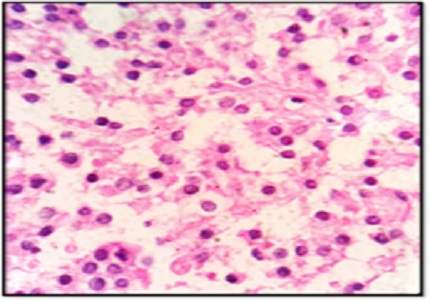Solid pseudopapillary neoplasms-experience from a tertiary care centre
Abstract
Introduction: Solid pseudopapillary neoplasms (SPN/FRANTZ TUMOUR) of the pancreas are rare neoplasms of low grade malignant potential which were first described in 1959 by Frantz. These account for 0.13–2.7% of pancreatic neoplasms and approximately 13% of surgically resected cystic lesions of the pancreas. We present our experience with these rare tumors.
Methods: Total 406 patients with pancreatic tumours were admitted in our department during the 10year period (Between 2007 and 2017) were reviewed, only 18 were diagnosed as having SPN(4.4%). Clinico-pathological details, intervention done and follow up of all the cases were studied and reported here.
Results: 17 patients were woman and1was Man with median age of 23 years (range 11 to 54 years). The tumor size ranged from 3.8 to17cm (average 6.4 cm).12 patients presented with pain in the abdomen, 4 presented with a painless mass, 1 was detected incidentally and1presented with Malena. In 7 patients the tumor was in the pancreatic head, in 3 it was in the neck, and in the remaining 8 it is in the body and tail. CECT was done in all cases. 8 patients under went Distal pancreatectomy with splenectomy, 1 underwent a PPPD, 6 patients required classical Whipple operation. 3 underwent central pancreatectomy. Immuno histochemistry showed positivity for beta catenin, vimentin, PR receptor and chromogranin negativity. All 18 patients were free of disease in a median follow- up period of 32 months (range 6 – 84) months.
Conclusion: SPNs are rare neoplasms, typically affecting young women without notable symptoms, with a low malignant potential but excellent prognosis. Radical surgical resection with clear margins is the treatment of choice.
Downloads
References
Papavramidis T, Papavramidis S. Solid pseudopapillary tumors of the pancreas: review of 718 patients reported in English literature. J Am Coll Surg. 2005 Jun;200(6):965-72.
Kim CW, Han DJ, Kim J, Kim YH, Park JB, Kim SC. Solid pseudopapillary tumor of the pancreas: can malignancy be predicted? Surgery. 2011 May;149(5):625-34. doi: https://doi.org/10.1016/j.surg.2010.11.005.
Kloppel G., Solcia E., Longnecker D.S., Capella C., Sobin L.H. Histological typing of tumors of the exocrine pancreas. World Health Organization International Histological Classification of Tumours; Berlin, Heidelberg, New York: Springer; 1996. (8452/1. ISBN [ISBN 3-540-60280-1])
Buetow PC, Buck JL, Pantongrag-Brown L, Beck KG, Ros PR, Adair CF. Solid and papillary epithelial neoplasm of the pancreas: imaging-pathologic correlation on 56 cases. Radiology. 1996 Jun;199(3):707-11.
Yu MH, Lee JY, Kim MA, Kim SH, Lee JM, Han JK, Choi BI. MR imaging features of small solid pseudopapillary tumors: retrospective differentiation from other small solid pancreatic tumors. AJR Am J Roentgenol. 2010 Dec;195(6):1324-32. doi: https://doi.org/10.2214/AJR.10.4452.
Baek JH, Lee JM, Kim SH, Kim SJ, Kim SH, Lee JY, Han JK, Choi BI. Small solid pseudopapillary tumors of the pancreas at multiphasic multidetector CT. Radiology. 2010 Oct;257(1):97-106. http://doi.org/10.1148/radiol.10092089. Epub 2010 Jul 27.
El-Bahrawy MA, Rowan A, Horncastle D, Tomlinson I, Theis BA, Russell RC, Stamp G. E-cadherin/catenin complex status in solid pseudopapillary tumor of the pancreas. Am J Surg Pathol. 2008 Jan;32(1):1-7.
Cavard C, Audebourg A, Letourneur F, Audard V, Beuvon F, Cagnard N, Radenen B, Varlet P, Vacher-Lavenu MC, Perret C, Terris B. Gene expression profiling provides insights into the pathways involved in solid pseudopapillary neoplasm of the pancreas. J Pathol. 2009 Jun;218(2):201-9. doi: https://doi.org/10.1002/path.2524.
Chen SQ, Zou SQ, Dai QB, Li H. Clinical analysis of solid-pseudopapillary tumor of the pancreas: report of 15 cases. Hepatobiliary Pancreat Dis Int. 2008 Apr;7(2):196-200.
Zhang H, Liang TB, Wang WL, Shen Y, Ren GP, Zheng SS. Diagnosis and treatment of solid-pseudopapillary tumor of the pancreas. Hepatobiliary Pancreat Dis Int. 2006 Aug;5(3):454-8.
Tipton SG, Smyrk TC, Sarr MG, Thompson GB. Malignant potential of solid pseudopapillary neoplasm of the pancreas. Br J Surg. 2006 Jun;93(6):733-7.
Patil TB, Shrikhande SV, Kanhere HA, Saoji RR, Ramadwar MR, Shukla PJ. Solid pseudopapillary neoplasm of the pancreas: a single institution experience of 14 cases. HPB (Oxford). 2006;8(2):148-50. doi: https://doi.org/10.1080/13651820510035721.
Huang HL, Shih SC, Chang WH, Wang TE, Chen MJ, Chan YJ. Solid-pseudopapillarytumor of the pancreas: clinicalexperience and literature review. World J Gastroenterol. 2005Mar7;11(9):1403-9.
Mao C, Guvendi M, Domenico DR, Kim K, Thomford NR, Howard JM. Papillary cystic and solid tumors of the pancreas: a pancreatic embryonic tumor? Studies of three cases and cumulative review of the world's literature. Surgery. 1995 Nov;118(5):821-8. Review.
Paruchuri RK, Kuruba HR, Pathapati D, Prayaga A. Role of preoperative multidetector computed tomography diagnosis of solid pseudopapillary tumours of the pancreas with postoperative surgical and histopathological correlation. West Afr J Radiol. 2017; 24(1):45-51.
Coleman KM, Doherty MC, Bigler SA. Solid-pseudopapillary tumor of the pancreas. Radiographics. 2003 Nov-Dec;23(6):1644-8.
Trivedi N, Sharma U, Das PM, Mittal MK, Talib VH. FNAC of papillary and solid epithelial neoplasm of pancreas--a case report. Indian J Pathol Microbiol. 1999 Jul;42(3):369-72. PubMed PMID: 10862301.
Naresh KN, Borges AM, Chinoy RF, Soman CS, Krishnamurthy SC. Solid and papillary epithelial neoplasm of the pancreas. Diagnosis by fine needle aspiration cytology in four cases. Acta Cytol. 1995 May-Jun;39(3):489-93.
Bardales RH, Centeno B, Mallery JS, Lai R, Pochapin M, Guiter G, Stanley MW. Endoscopic ultrasound-guided fine-needle aspiration cytology diagnosis of solid-pseudopapillary tumor of the pancreas: a rare neoplasm of elusive origin but characteristic cytomorphologic features. Am J Clin Pathol. 2004 May;121(5):654-62.
Marchegiani G, Andrianello S, Massignani M, Malleo G, Maggino L, Paiella S,Ferrone CR, Luchini C, Scarpa A, Capelli P, Mino-Kenudson M, Lillemoe KD, BassiC, Castillo CF, Salvia R. Solid pseudopapillary tumors of the pancreas: Specific pathological features predict the likelihood of postoperative recurrence. J Surg Oncol. 2016 Oct;114(5):597-601. doi: https://doi.org/10.1002/jso.24380. Epub 2016 Jul 29.
Klimstra DS, Wenig BM, Heffess CS. Solid-pseudopapillary tumor of the pancreas: a typically cystic carcinoma of low malignant potential. Semin Diagn Pathol. 2000 Feb;17(1):66-80.
González-Cámpora R, Rios Martin JJ, Villar Rodriguez JL, Otal Salaverri C, Hevia Vazquez A, Valladolid JM, Portillo M, Galera Davidson H.Papillary cystic neoplasm of the pancreas with liver metastasis coexisting with thyroid papillary carcinoma. Arch Pathol Lab Med. 1995 Mar;119(3):268-73.



 OAI - Open Archives Initiative
OAI - Open Archives Initiative


